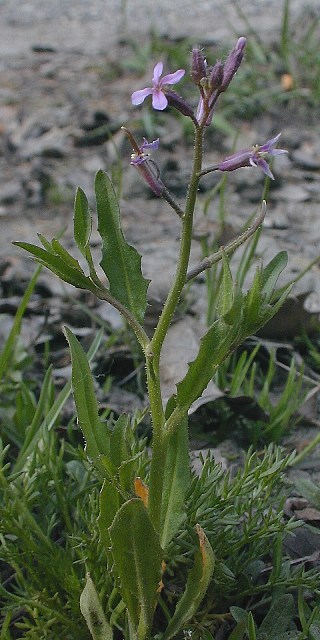Description:
This plant is a winter or early spring annual about ½–2' tall. It
is more or less erect and branches occasionally. The round stems are
light green and sparsely covered with short glandular hairs. The
alternate leaves are greyish or bluish green and up to 2½" long and
2/3" (17 mm.) across. They are narrowly ovate or oblanceolate, dentate
and
slightly undulate along the margins, and sparsely covered with short
glandular hairs. The tip of each leaf is blunt or acute; it tapers
gradually to a petiole-like base. The upper stems terminate in racemes
of flowers up to 1' in length. Only a few flowers bloom at the apex of
each raceme, while the siliques (slender seedpods) develop below. The
central stalk of each raceme has a tendency to zigzag between the
flowers. Each flower is about ½" across and ½" long. It consists of 4
narrow petals that are pink to purplish pink, 4 linear sepals that are
purplish pink and slightly hairy, several stamens, and a pistil. The
throat of this flower is quite narrow; its calyx is cylindrical, while
the petals are widely spreading and form a cross. The blooming period occurs from mid-spring
to mid-summer and lasts about 2-3 months. There is no noticeable floral
scent. Each flower is replaced is replaced by a stout silique that
curves upward and tapers to a beak. The pedicel of each silique (or
flower) is quite stout and about 1/3" (8 mm.) long. Each silique is
about 1–1½"
long when fully mature. The seeds have a smooth surface and are
slightly flattened. The root system consists of a stout taproot. This
plant spreads by reseeding itself.
spreading and form a cross. The blooming period occurs from mid-spring
to mid-summer and lasts about 2-3 months. There is no noticeable floral
scent. Each flower is replaced is replaced by a stout silique that
curves upward and tapers to a beak. The pedicel of each silique (or
flower) is quite stout and about 1/3" (8 mm.) long. Each silique is
about 1–1½"
long when fully mature. The seeds have a smooth surface and are
slightly flattened. The root system consists of a stout taproot. This
plant spreads by reseeding itself.
Cultivation:
The preference is full sun and mesic to dry conditions. Blue Mustard
tolerates different kinds of soil, but it is more commonly found in
poor soil that contains clay or gravel because of the reduced
competition from other plants.
Range & Habitat:
Blue Mustard is an uncommon plant that occurs primarily in NE Illinois
and scattered counties elsewhere (see Distribution
Map). It is originally from Asia and can be found as an
adventive plant in the drier Western states, where it is more common.
In Illinois, local populations usually don't persist. Habitats include
areas along railroads and roadsides, stock yards, and nursery grounds.
Disturbed areas are preferred.
Faunal Associations:
The nectar of the flower is accessible to long-tongued bees, beeflies,
butterflies, skippers, and moths. The mouthparts of other insects are
too short. Little is known about this plant's relationships to birds
and mammalian herbivores. The foliage is not considered to be toxic; it
is possible that the seeds can pass through the digestive tracts of
livestock, facilitating the dispersal of this plant to new areas.
Photographic Location:
Along a roadside near Urbana, Illinois, where there was scant
vegetation. This plant abruptly disappeared about a month after it was
photographed. Judging from the tire tracks in the mud, it may have been
run over by a truck.
Comments:
Usually, members of the Mustard family have small white or yellow
flowers with nectar that is accessible to insects with short
mouthparts. Blue Mustard is distinctive in that each flower has narrow
pink or purplish pink petals, a tubular calyx, and a small throat.
Other members of the Mustard family with pink or purple flowers include
Hesperis matronalis (Dame's Rocket), Lunaria
annua (Money Plant). However, the flowers of Dame's Rocket
and the Money Plant are larger (more than ¾" across) and their petals
are more rounded. Another species in the Mustard family with similar
flowers is Iodanthus pinnatifidus (Purple Rocket).
However, this latter species has light blue-violet flowers, glabrous
stems, and broader leaves toward the base of the plant that are
pinnately lobed or ovate with serrated margins. The siliques of Purple
Rocket lack a beak and they are more straight than the siliques of Blue
Mustard.